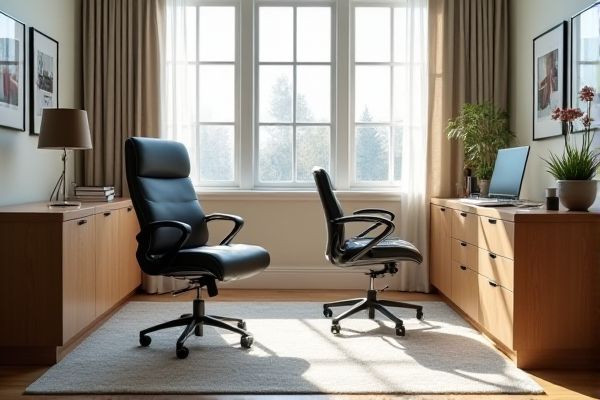
Task chairs offer ergonomic support and adjustability designed for long hours of focused work, making them ideal for your everyday office tasks. Executive chairs provide a higher level of comfort and style with premium materials and features, suited for leadership roles and making a statement in your workspace; explore the full article to find which chair matches your needs best.
Table of Comparison
| Feature | Task Chair | Executive Chair |
|---|---|---|
| Design | Compact, simple, ergonomic | Large, luxurious, formal |
| Purpose | Daily office tasks, short to medium seating | Extended use, managerial roles |
| Material | Mesh or fabric, lightweight | Leather or high-quality synthetic, sturdy |
| Adjustability | Basic (height, tilt) | Advanced (height, tilt, lumbar, armrests) |
| Support | Moderate ergonomic support | Enhanced lumbar and back support |
| Price Range | $100 - $300 | $300 - $1000+ |
| Weight Capacity | Standard (up to 250 lbs) | Heavy-duty (up to 300+ lbs) |
| Mobility | High, lightweight with casters | Moderate, heavier base with casters |
Understanding Task Chairs and Executive Chairs
Task chairs prioritize ergonomic support and mobility, featuring adjustable height, lumbar support, and swivel capabilities designed for prolonged desk work. Executive chairs emphasize luxury and presence with high-back designs, premium materials such as leather, and enhanced cushioning for comfort during extended meetings. Both chair types cater to different office needs, balancing functionality and aesthetics for task-focused efficiency or executive stature.
Key Differences Between Task and Executive Chairs
Task chairs prioritize ergonomic support and adjustability, making them ideal for long hours of focused work with features like lumbar support and swivel bases. Executive chairs emphasize luxury and status, typically constructed with high-quality leather, padded armrests, and taller backrests for enhanced comfort and authority appearance. Your choice depends on whether you value functional workspace efficiency or a commanding office presence.
Ergonomics: Comfort and Support Compared
Task chairs prioritize ergonomic design with adjustable lumbar support, seat height, and armrests to promote proper posture during extended use. Executive chairs typically offer enhanced cushioning, higher backs, and headrests, providing superior comfort and support for prolonged sitting periods. Both types aim to reduce strain, but executive chairs often emphasize luxury and comprehensive ergonomic features for executive environments.
Design and Aesthetics: Style Matters
Task chairs feature ergonomic designs with breathable mesh backs and minimalist frames, promoting comfort and functionality in modern office settings. Executive chairs emphasize luxury through plush leather upholstery, high backs, and sophisticated contours, reflecting authority and professionalism. Style matters in selecting a chair that complements the workspace ambiance while meeting individual ergonomic needs.
Functionality and Adjustability Features
Task chairs prioritize ergonomic support and adjustability, offering features like height adjustment, swivel capabilities, and lumbar support to enhance comfort during long hours of focused work. Executive chairs emphasize luxurious comfort with advanced adjustability, including reclining functions, padded armrests, and headrests, designed to provide superior support for extended sitting periods. Your choice depends on whether you need a chair optimized for active task performance or a more cushioned, adjustable option for executive environments.
Material Quality and Durability
Task chairs typically feature breathable mesh or fabric upholstery combined with plastic or lightweight metal frames, emphasizing ergonomic support and durability for daily use. Executive chairs often use high-quality genuine leather or bonded leather with sturdy hardwood or metal frames, designed to offer longevity and a premium feel. The superior material quality of executive chairs generally results in enhanced durability compared to the more utilitarian construction of task chairs.
Suitability for Different Work Environments
Task chairs are designed for dynamic work environments requiring frequent movement and adjustability, making them ideal for collaborative office spaces or hot-desking scenarios. Executive chairs provide superior comfort, support, and a prestigious appearance, best suited for managerial offices or settings where long hours of focused work and client meetings occur. Your choice depends on the nature of your work, prioritizing flexibility with a task chair or enhanced ergonomics and status with an executive chair.
Price Comparison: Value for Money
Task chairs typically offer a budget-friendly option ranging from $100 to $300, providing essential ergonomic features suitable for daily use. Executive chairs, priced between $300 and $800 or more, tend to feature premium materials, enhanced padding, and advanced adjustability for long hours of comfort. For cost-conscious buyers seeking functional seating, task chairs deliver excellent value, while executive chairs justify higher prices with superior durability and luxury.
Choosing the Right Chair for Your Needs
Selecting between a task chair and an executive chair depends on your workspace requirements and comfort preferences. Task chairs offer ergonomic support with adjustable features ideal for prolonged desk work, while executive chairs provide enhanced padding and a commanding design suitable for leadership roles. Your choice should prioritize functionality and posture support to boost productivity and reduce fatigue.
Final Verdict: Task Chair vs Executive Chair
Task chairs offer ergonomic support and flexibility suited for dynamic work environments, making them ideal for prolonged computer tasks and active office roles. Executive chairs provide enhanced cushioning and a commanding presence, catering to leadership positions where comfort and style reflect authority. Your choice should align with your work habits and office ambiance, balancing functionality with status.
 homyna.com
homyna.com